This challenge was inspired a great many years ago when I saw Indiana Jones for the first time. I still haven’t made it out to Petra in person, but I will one day.
Trek to Petra Virtual Challenge will take you 65 km (40mi) from Dana to the Red Rose City of Petra — one of the New 7 Wonders of the World. This iconic hike explores the remote canyons, valleys and deserts of Jordan.
When I started this challenge, I thought I would share with you a nice lamb recipe with pomegranate molasses with the postcards. Only problem is, that’s not where my head is at right about not. I’ll try to circle back to it later.
I don’t know if its this random head cold I picked up, but I am having some trouble keeping focused. My work’s trying to figure out some kind of hybrid back to the office plan, but I’ve been downtown a total of three times in over two years, instead of five or more a week, every week. Each time has re-enforced that I am not exactly comfortable in urban environments. Ask poor Michael, who watched me lose a chunk of my mind lost in an underground parking garage, surrounded by concrete and metal and glass. It’s hard to imagine returning to Toronto for long periods of time with a return to the office.
Besides, all my stuff is in a plastic moving bin, where it has been rotting for 2 and a bit years. 5 pairs of shoes, a makeup case, an emergency kit, probably 2 or 3 ziplock bags of dried snacks, assorted pens, papers, and a collection of alligator clips that would be the envy of most folks. I am not entirely sure the shoes will even be wearable after so long in close proximity to a bag of dried fruit. So, lets use the next few moments to picture what I’ve been imagining. It is firmly back on the Indiana Jones theme. Imagine it… there’s my bin sitting in a giant warehouse, dimly lit, that I will have to search through, like I am searching for the Lost Ark.
One last personal tidbit on the Indiana Jones theme… while Indiana Jones (the man) was named after Indiana (the dog), I named one of my servals (a cat) after Indiana Jones (the man).
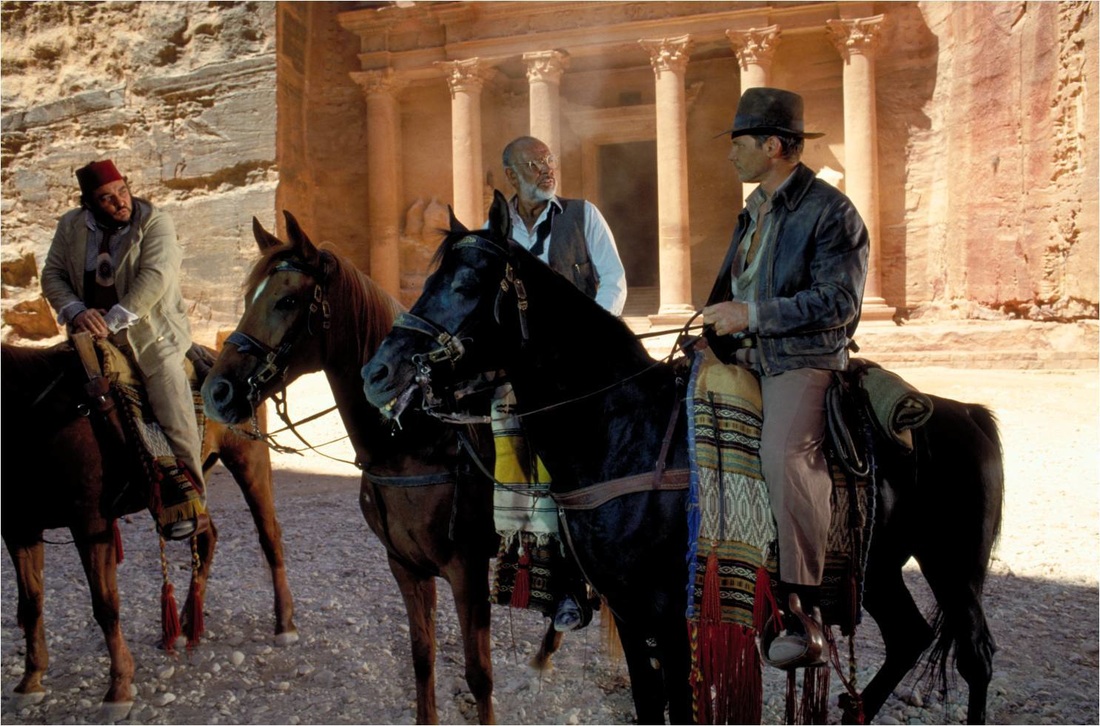

Postcards
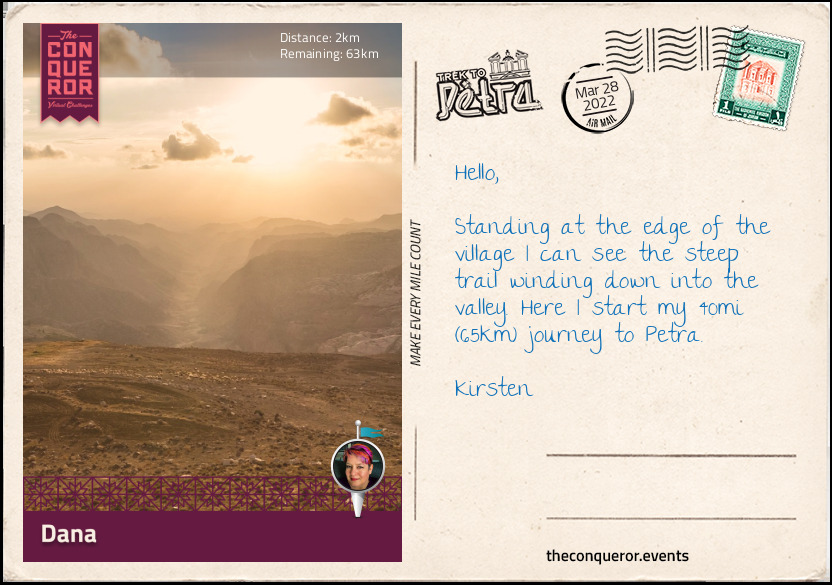
Perched up high on the edge of Wadi Dana, a river valley, was the ramshackle village of Dana. Inhabited since the Ottoman era this once thriving farming community was largely abandoned by the mid-20th century with most families moving to nearby towns for better infrastructure, jobs and education.
With the deserted houses crumbling and traditional culture fading, a group of women from Amman intervened in the 1990s and slowly revitalised the village by repairing houses and installing electricity, phones and water supply. In 2012 Dana was further renovated with hotels, restaurants and shops opening to tourists.
My journey to Petra began on the outskirts of the village at an elevation of 4100ft (1250m). As I stood at the edge of the mountain plateau I pondered the journey to come, the ruggedness I would encounter, the people I would cross and the food I would savour.
Whilst I’m talking about food, before I started my trek I filled my belly with Jordan’s national dish called Mansaf, made of lamb cooked in a fermented yoghurt sauce served with rice and sprinkled with parsley.
Pleasantly full with a good dose of protein and carbs, I made my way down into the valley on a well-tended and well-marked trail. The first mile was a series of difficult switchbacks as the descent to the valley floor was a fairly quick drop of 1300ft (400m). Having to maintain my balance on a gravel track with small loose rocks, each step was careful and measured.
Once in the valley I took in the vastness of this wadi. The towering cliffs on either side, the discernible geological layers illustrating its age and the hues of pink on its rock face. Somewhere in the distance is Feynan Ecolodge, my overnight stopover.
Geared up with snacks and plenty of water, as there aren’t any top-up facilities before Feynan, I headed into the wadi following the still well-marked trail.
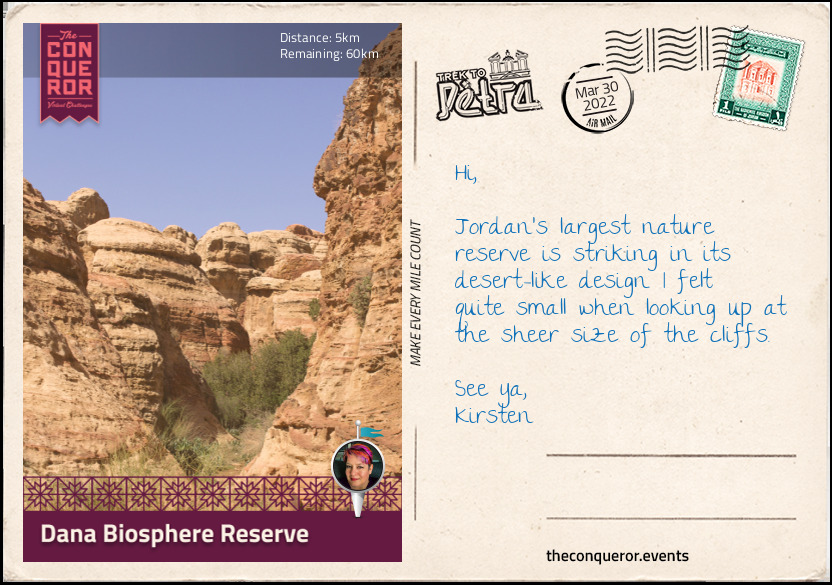
As part of Dana’s revitalisation in 1993 World Bank and The United Nations provided partial funding to create the Dana Biosphere Reserve and added a small research facility to study the ecology of the area.
The Biosphere Reserve covers 115mi² (300km²) of mountain ridges, plateaus and desert plains along the Great Rift Valley, encompassing four different bio-geographical zones. The geology of the reserve changes from limestone to sandstone to granite.
Over 800 species of plants have been recorded with including three new species. More than 200 birds and nearly 40 species of mammals have been catalogued in the reserve of which species such as the Syrian Serin (small bird), Lesser Kestrel (small falcon) and Nubian ibex are endangered and threatened by hunting.
The Reserve runs the full length of Wadi Dana all the way to Feynan Ecolodge. Besides its towering cliffs, the rocky area is covered with small trees and shrubs. The geology of the wadi is primarily sandstone.
Making my way through the wadi along the dry river bed I was continuously awed at the landscape, at how the vegetation adapted to such an arid environment, the surrounding scrubland, the occasional desert flowers and the constant pink, rugged cliffs on each side.
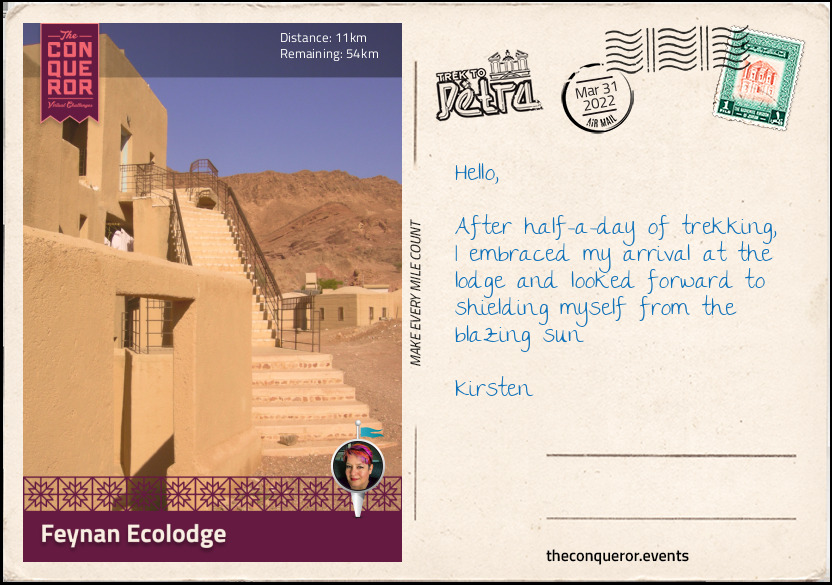
Trekking on the exposed trail, I felt the brunt of the sun as it radiated in its full glory. With little shade on offer I welcomed reaching the end of Wadi Dana and squirreling myself away in Feynan Ecolodge. The elevation has dropped from 4100ft (1250m) at the top, above the valley floor, to 800ft (240m).
Built in 2005 and first of its kind in Jordan, the lodge was inspired by the historical roadside inns found along the Silk Road known as caravanserai. These ancient inns were resting stops for caravans travelling on long journeys across Central Asia, China and Europe and a place for travellers to share stories, trade ideas and gain knowledge.
The lodge is located at the confluence of Wadi Dana and Wadi Feynan. The area is historically known for its copper deposits and its intense extraction between 4500 BC to 1516 AD. In the past 30 years the area has been continuously explored and studied hoping that more copper could be found to provide Jordan with much needed natural resources. The results to date have been meagre and economically not viable. Of greater concern to various groups is the environmental impact should any digging and extraction occur.
By building the lodge the local Bedouin community were provided with a source of employment. There are four main tribes that live around the Feynan area who continue to live in their traditional tents known as beit al-sha’ar, translated as ‘house of hair’ because the tents are made of goat-hair. As they continue with their traditional life of herding goats, sheep or camel and moving camp from valley to plateau depending on the season, the local Bedouin are also slowly adapting to the modern world by acquiring phones, pick-up trucks, plastic water containers and kerosene stoves. Access to water, electricity, doctors and schools has driven many Bedouin to give up their traditional way of living and move into villages but those that remain, with the exception of finding a good spot for mobile reception, continue to hold onto their simple way of life and connection with nature.
Dinner at the lodge was a vegetarian adaptation of Arabic cuisine. I enjoyed the simple yet tasty serve of Mujadara, a combination of rice and lentils topped with caramelised onions served with a side of Baba ganoush, chopped roasted eggplant tossed with tomatoes and onions.
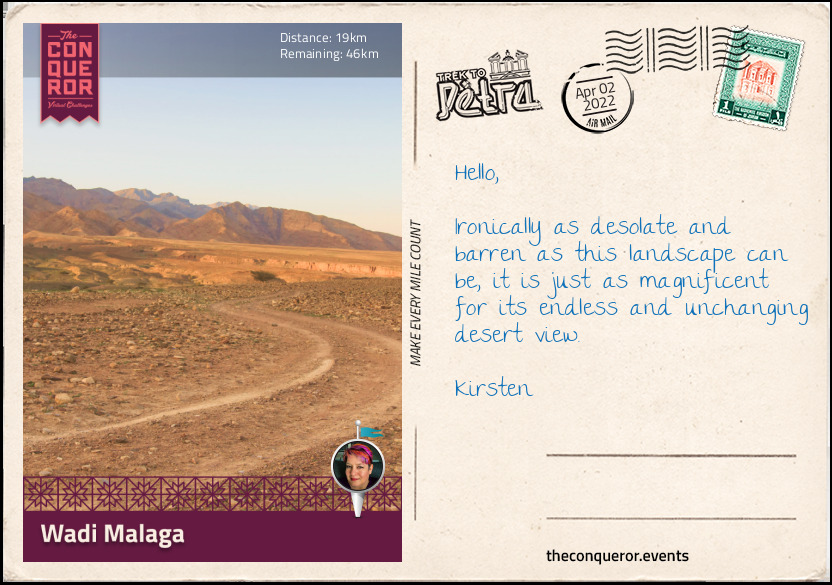
Preparing for the day ahead, I indulged in a hearty breakfast of falafel, hummus and pita bread. Topping up with coffee and replenishing my water bottle, I headed out for the next 5mi (8km) to Wadi Malaga campsite.
The trail was flat and completely desert. Wide open spaces devoid of vegetation abounded. I passed a small settlement, a local mosque and a local camp where I veered off bypassing the village of Feynan.
Passing Bedouin shepherds tending their herd, we exchanged warm greetings. Bedouin people are known to be friendly and hospitable. It was not long before I found myself seated in a Bedouin camp enjoying a sweet tea. Slowly brewing in a kettle over a small fire, the tea was a base of black tea leaves together with dried sage, cardamom pods, cinnamon bark and a good dose of raw sugar which gave it the very sweet flavour.
Crossing several dry riverbeds and a dried up reservoir I reached the Wadi Malaga Campsite. With a little bit of shelter from nearby hills, I took a moment to rest, rehydrate and replenish my energy stores with a snack. From here the next stage of my trek was an 8mi (13km) stretch to Ras Al-Feid for an overnight stop.
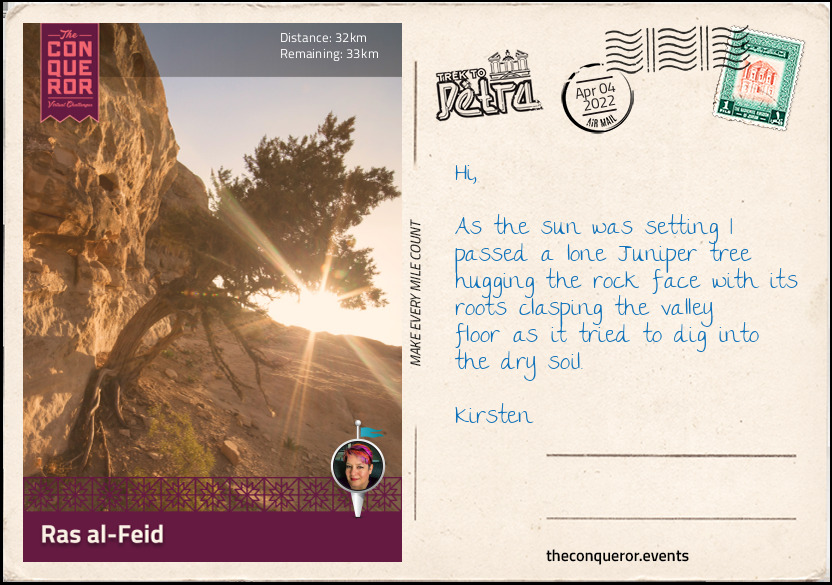
Having left Wadi Malaga campsite, I headed due south travelling along the side of several small hills Jabal al-Hamra, Jabal Mahzan and Jabal Barwas. To the west I was greeted with the vast expanse of the Araba Valley and to the east I had the rising mountains.
The trail gradually ascended across Wadi Barwas, with desert dunes to my right and black magmatic mountains on my left. I continued alongside the mountain until I reached a shallow wadi where I turned left to climb the trail on switchbacks through jagged rocky mountains. The path was an old Bedouin route that led me over Ras Naqb Shdeid, a mountain saddle with aerial views in all directions.
Continuing downhill via a steep descent, I emerged in a small gully near the spring-fed Wadi Feid. Following a short right turn I was delighted to come across a pool where I was able to top up my water bottle, as this was the last reliable water source, and take the opportunity to cool off and wash up.
After some rest, I rejoined the trail in Wadi Feid and continued through thick vegetation, welcoming the shade. Passing an old Nabatean water channel, I had to wade through some water and past a spring until I turned another bend and found myself in dry desert again. Trekking for a further mile, I reached my campsite signalling the halfway point and the end of another stage.
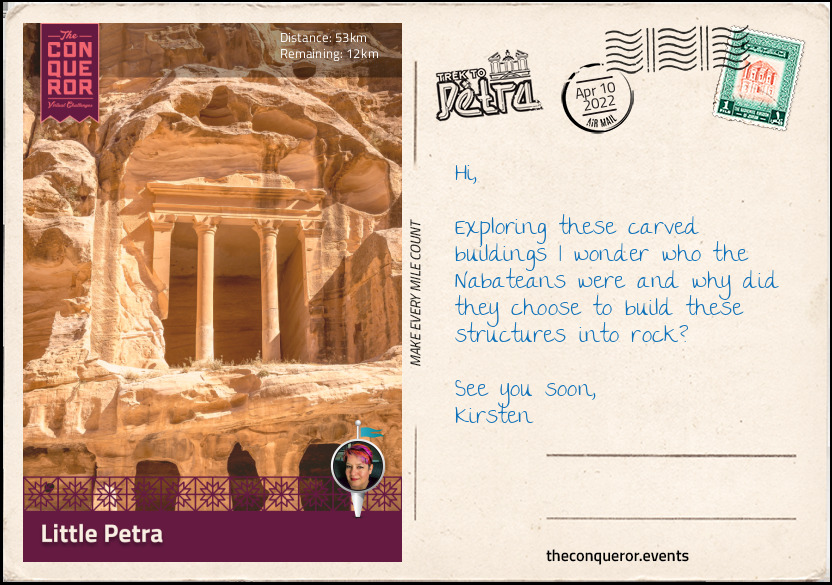
The trail from Ras al-Feid was along rocky sandstone terrain with a steady upward climb for the next mile or so (2km). The desolate and barren landscape was constant with the occasional appearance of desert vegetation until I arrived at the outskirts of Petra Archaeological Park. A UNESCO World Heritage Site since 1985, the Park covers an area of 264,000m² of rocky mountains and the ancient city of Petra. Listed as one of the 7 Wonders of the World, Petra holds the history of the Nabatean people and a multitude of buildings carved into the rock some 2,000 years ago.
Entering a narrow canyon, I arrived at Little Petra, also known as Siq al-Barid (‘the cold canyon’). Archaeologists surmise that Little Petra was once a suburb of Petra. Consisting of three wide open spaces with buildings carved into the rock, Little Petra was connected by a small canyon of 1,480ft (450m) in length.
The first building I stopped to explore was the Painted Biclinium. A double storey structure, it had a dining room on the upper floor that was accessed via a wide staircase followed by a narrow and weathered set of steps. Inside the biclinium was a niche (a recessed section of the room with a half-dome top) and on its curved ceiling was a well preserved painting of vines, grapes, birds, flowers and Cupids (a flute player and an archer). Primarily painted in a rich dark brown and ochre, elements of dark blue and green were also present. Following restoration in the late 2000s, gilding was also found on vine leaves. The artwork was carbon dated to sometime between 40BC and 25AD.
Back outside and a little further through the narrow canyon, the area opened up into a square and to my right in the rockface was what seemed to be a temple structure built on top of cave-like rooms beneath it. The temple façade consisted of four pillars topped with Nabatean horn capitals. The pillars were most likely for aesthetics since the building did not require any support as it was carved into the rock.
Trekking through another narrow section of the gorge, I arrived at another open space where a set of steps led up to a single door of a small building that once served as a tomb. A dark empty chamber I stepped outside and marvelled at the effort, the skills, the tools and the workforce needed two millennia ago to carve these structures.
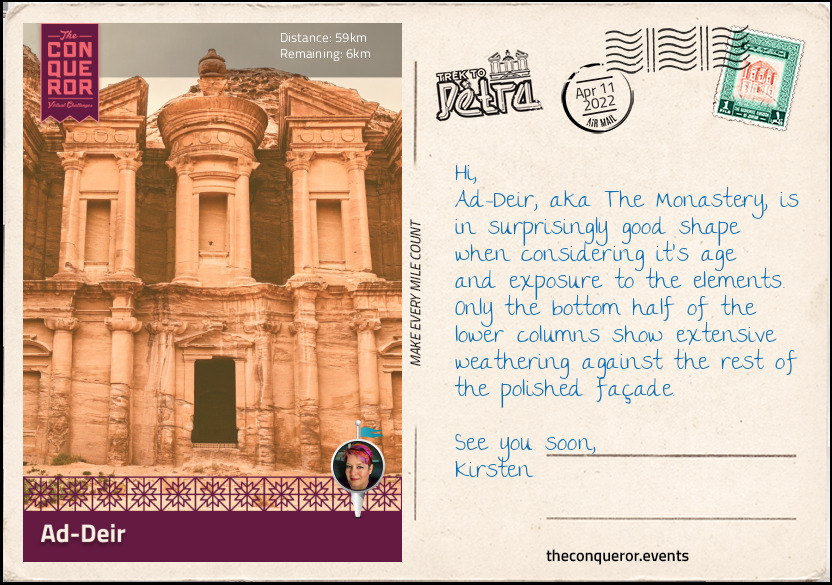
At the end of the canyon at Little Petra, I turned right to follow the path past Al-Beidha (translates as “the white one”), the remains of a Neolithic village from circa 7200-6500 BC. The excavation site is a series of leftover masonry showing that the houses were built round with underground floors. Since the village was established at the advent of agriculture evidence shows barley and emmer wheat were cultivated. At its height the village had a population between 125-235 people. The village was eventually abandoned until a Nabatean tribe settled in the area between 1-2 century BC.
The trail continued with subtle ups and downs until I found myself on the back trail known as The Monastery Route. The climb was a combination of rocky paths and shallow yet deep steps. The further up I went the closer I found myself hugging the mountain side aiming to avoid the sheer drop to the right of me. A good head for heights was most certainly welcome on this section of the trail but what was really breath-taking was the bird’s eye view of the rugged mountains with the unrelenting sun beating down upon it. Devoid of life and vegetation these mountains were almost stoic in their presence.
As I pushed on the trail became less discernible, a constant consideration of whether I was heading in the right direction, whether the rocks beneath my feet were loose and slippery, if the bend in the path ahead was open to the elements but all along the views were unyielding in their rose colour, their ruggedness and layers upon layers of ancient sedimentary rocks.
The path eventually opened up and led me into Ad-Deir, an iconic monastery built in the mid-1st century. Carved out of rock the monastery is 157ft (48m) tall and 154ft (47m) wide. It looks like a massive double storey building but it consists of only one huge chamber. The entryway is enormous in height that may have at one time had steps for access but it is no longer there. To enter I had to climb up about 6ft (2m) to get inside. The square chamber inside consisted of a recessed section on the back wall. On each side it had 4 steps, built-in pillars and an arched top. Whilst it is thought that the interior was once plastered and painted, no decoration has survived.
Outside the architecture consists of numerous pillars on both ground and first level and half-pediments at the top. Classified as Nabatean architecture, it is also influenced by Hellenistic (c323BC+) and Mesopotamian (pre-332 BC) styles – essentially pre and post Alexander the Great period.
Nabatean refers to the nomadic people that occupied the region. Originally hailing from northern Arabia, they roamed the Arabian desert searching for pasture and water for their livestock. Moving into southern Jordan around 6thC BC, by the 3rdC BC the Nabatean Kingdom was established with Raqmu (present day Petra) as its capital city.
Across from the monastery was a sheltered Bedouin café, where I rested with a cup of local tea whilst I admired the precise architectural features of the building. What further treasures will Petra hold?
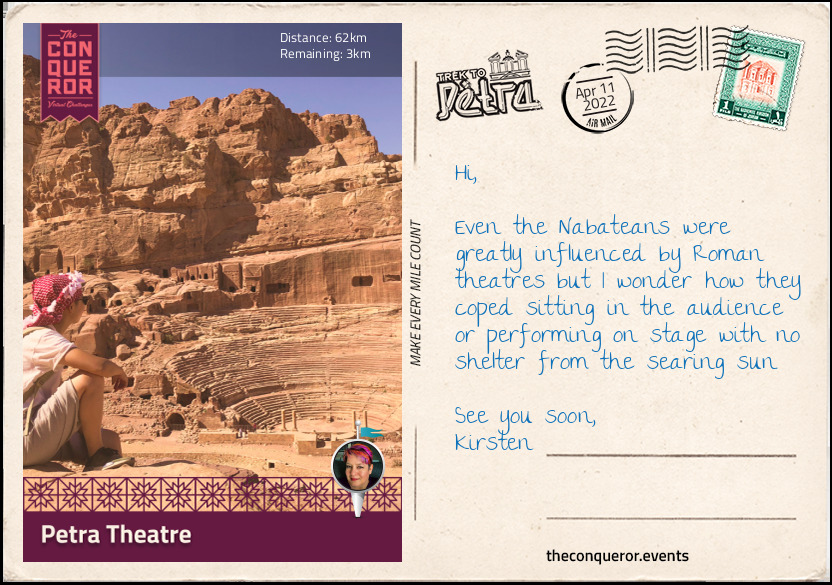
Making my way downhill through a series of steps, I found myself in a very narrow canyon barely a metre wide in some sections and the rock faces towering above filtering limited light. The path ahead was somewhat rough and uneven with a fissure beside it that was sprouting with pretty pink bushes. The path narrowed further until more stairs led me down to the city centre of Petra.
Located in a basin and surrounded by mountains, Petra was at the centre of two major trading routes: 1. connecting the Gulf of Aqaba in the south to the Dead Sea in the north and 2. Connecting the Persian Gulf from the east to the Mediterranean in the west. Caravans travelling the routes would look for supplies and water stopping in Petra as the midway point. The Nabateans recognised the opportunity before them and charged taxes on the caravaners and fees for services supplied, subsequently getting involved in trade themselves. Petra flourished, giving the Nabateans the means to build their rock-cut temples and royal tombs.
The main street began with Qasr al-Bint, a religious temple that was one of the best preserved and largest freestanding buildings to survive. Next I passed the Great Temple. Built in the early first century AD, the Temple was a large complex of around 7,560 m². A steep set of stairs led to the entry of the temple, which consisted of a small theatre, a residential quarter, roman baths, water tanks, places of worship and rows of columns.
As the street curved there was a turn off to see the Royal Tombs, a collection of four grand tombs grouped together in the cliffs. The first one is the Urn Tomb carved with two columns on either side of a massive entrance and a chamber that is 56ft (17m) deep. Outside was a courtyard flanked by a 5 column colonnade on one side and a small gift market on the other. The next one was the Silk Tomb and although not particularly interesting architecturally what made this tomb impressive was its marbled façade in shades of red, pink, white and grey. The marbling effect was so striking that it has been likened to watered silk. Moving onto the Corinthian Tomb, it has sadly been weathered so extensively that the once polished façade and precisely cut columns are slowly returning to their natural state. Finishing with the Palace Tomb, this three storey building at 160ft (49m) wide and 150ft (46m) tall is one of the largest façades in Petra. What makes this one unique is that part of the structure is actually built above the rock face whilst the rest of it is carved into the rock. It is the only such structure in Petra. The first storey consists of four irregular entrances flanked by columns with the outer two entrances having arched pediments as opposed to the triangular ones on the inner two. The second storey had 18 columns unevenly spaced. The third storey was above the existing rock and was constructed with blocks making it prone to decay along the left side of the building. What little remains shows signs of even more columns although not quite as elaborate as those on the lower levels.
Heading back to the main street I made my way to the theatre. It was largely carved out of rock with the exception of the stage and exterior walls that were constructed from blocks. The semi-circular seating had a diameter of 310ft (95m) and was carved in three distinct sections with passageways in-between. Beneath the seats were a network of passages to help exit the auditorium via barrel-vaulted entrances located on either side of the theatre. Able to accommodate 8,500 people, the seating order was dictated by social rank with the lower seats reserved for the elite. The theatre was positioned in such a way that it brought as many tombs as possible into view. When the Romans annexed Petra in 106 AD, the theatre was enlarged by cutting through some of the older tombs that are still visible in the smoothed rock face at the back of the seating area.
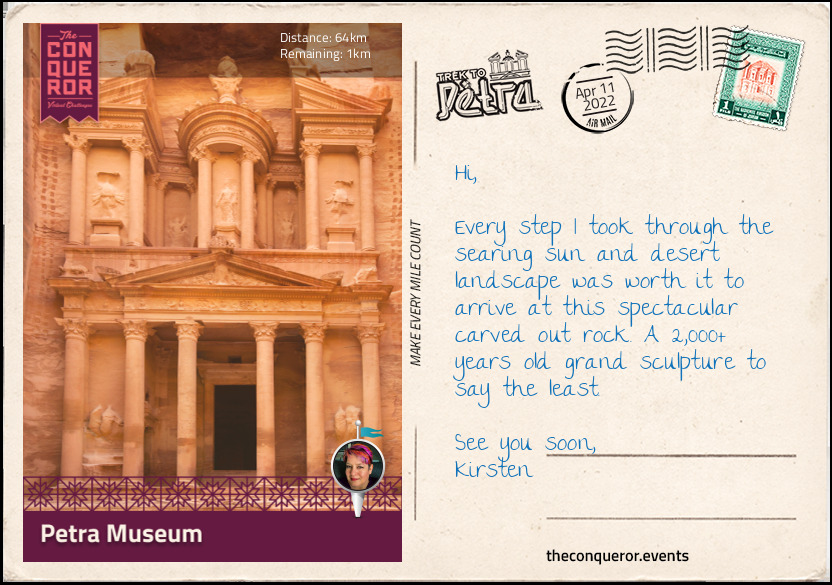
Less than a mile from the theatre I arrived at the most famous ancient wonder in Petra known as Khazneh, aka The Treasury. Unlike Ad-Deir (The Monastery) that is connected to the rock behind it, The Treasury is tucked into the rock preserving its façade from prevailing winds, rain and flash floods. It is 100ft (30m) wide and 130ft (40m) tall designed in a classical style influenced by Greek and Roman architecture. Six Corinthian columns topped with a triangular pediment leads to an antechamber with three entrances – left, right and centre – that then lead into the burial chambers.
The top floor also has six columns but it is not topped with a pediment as is typical of classical architecture because the weight would have pressed on the lower floor. Instead, two half pediments are erected on either side of a circular central feature with an urn on top. It was believed that the urn contained treasure and the local Bedouin would fire their rifles at the urn in the hope that it would break and release the treasures, hence the name of the structure. However, the inside is very much tomb-like and it is likely that the story around the treasures was a fallacy.
The forecourt of the Khazneh used to be at least 19ft (6m) lower during the Nabatean times and before Khazneh existed there used to be three tombs carved into the rock which was partly demolished to make way for Khazneh. Being at a higher level than the forecourt, access to Khazneh was via a staircase about 43ft (13m) long and 16ft (5m) wide leading over the older tombs.
When the trading routes moved northwards, Petra went into irreversible decline and the Nabateans left. The city continued to stumble along with other settlers until around the 7th century and the last evidence of its habitation was in the 13th century during the Crusades. With Petra’s abandonment the dams that controlled the water flow were no longer maintained exposing the city to regular flash floods that filled the forecourt and damaged the lower part of the structure with rubble.
Petra remained in obscurity, a forgotten city until 1812 when a young Swiss explorer during his travels to Egypt heard a rumour about an ancient city in a narrow valley. To protect his identity he disguised himself as an Arab and hired a Bedouin guide to take him under the guise that he wanted to sacrifice a goat at a tomb. Whilst exploring the city his guide grew suspicious about his purpose and hurried him to complete the sacrifice of the goat.
When Petra was announced as one of the 7 New Wonders of the World, tourism exploded and by 2019 over a million people have visited the site. Anyone familiar with the feature film Indiana Jones: The Last Crusade [1989] will remember the last scene filmed in the forecourt of Khazneh.
The final stretch of my journey was through the Siq, a long gorge with steep walls up to 230ft (70m) high that wound for the next three-quarters of a mile (1.2km). Leaving Khazneh, I entered the Siq through a cleft of the sandstone mountain. Limited light filtered through a narrow slit between the towering cliffs but it didn’t last long. The path widened with natural light flowing into the canyon where I could see the ancient water channels carved into the rock. Along both sides of the canyon wall were several sacred stones inside niches. As I carried on the canyon briefly narrowed once again with only a slither of light coming through until it reopened into a wider path with the sun shining and the mesmerising colours in the rock face. A combination of pink, white, deep orange and grey with intermittent desert plants created a constant visual display. I reached the end through the remains of an arch that once crowned the entrance to the Siq. The arch collapsed in 1896 after an earthquake.
Passing the Obelisk Tomb, an unusual burial complex with four pointed pillars of about 23ft (7m) high, I welcomed my arrival at the Petra Museum where I concluded my 40mi (65km) hike from Dana.
It was time for a feast and I have been holding out for the upside down dish called Maqluba. Made of meat, rice and vegetables it is stacked in layers and when the pot is flipped the extracted Maqluba ends up looking like a layered cake. I cleansed my savoury palate with a serving of Halva, a dessert that originated in Persia, made from sesame flour, milk and pistachios.
Let me leave you with this sonnet written by John W Burgon in 1845 about Petra:
“It seems no work of Man’s creative hand,
by labour wrought as wavering fancy planned;
But from the rock as if by magic grown,
eternal, silent, beautiful, alone!
Not virgin-white like that old Doric shrine,
where erst Athena held her rites divine;
Not saintly-grey, like many a minster fane,
that crowns the hill and consecrates the plain;
But rose-red as if the blush of dawn,
that first beheld them were not yet withdrawn;
The hues of youth upon a brow of woe,
which Man deemed old two thousand years ago,
match me such marvel save in Eastern clime,
a rose-red city half as old as time.

